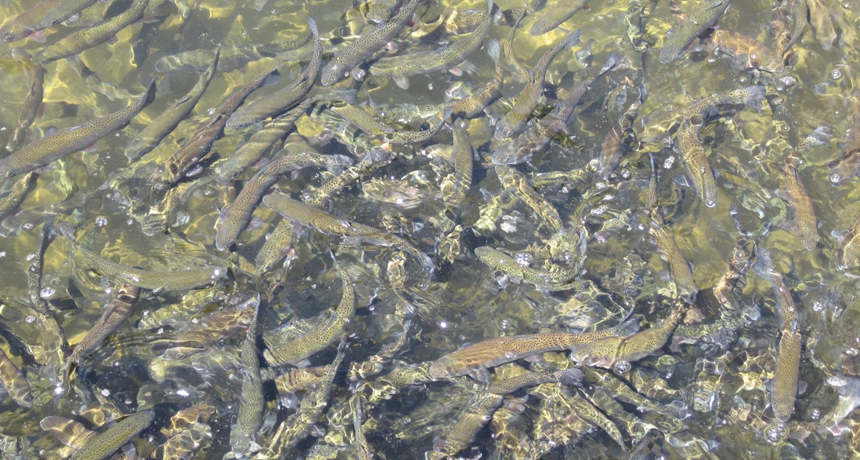
DISORIENTED In a hatchery, young steelhead trout, each about 20 centimeters long, may experience such odd magnetic fields that they fail to properly calibrate their inherited magnetic sense.
Emily Putman
Young steelhead trout don’t get off to a good start as navigators if they’re reared in hatchery tanks where iron pipes cause weirdness in magnetic fields.
The trout, like many other animals, sense Earth’s magnetic field and use it when they migrate. Yet young fish raised with magnetic distortions from a pipe and rebar in concrete flooring failed to orient normally in a simulated magnetic field, says marine biologist Nathan Putman, now at the Southeast Fisheries Science Center in Miami.
In a recent study, Putman had concluded that young migratory fish can inherit their magnetic maplike sense of their future ranges. But the fish confusion in new tests suggests that scientists need to account for experience as well as genetics, he and his colleagues report June 4 in Biology Letters. And if the early influence of magnetically disturbed homes persists later in a fish’s life, the new experiment might start to explain why hatchery fish often fail to return to their expected spawning grounds.
These steelhead trout, Putman says, “are a big deal to a lot of people.” Both commercial fishing operations and sports enthusiasts treasure them, and Pacific tribes consider them part of their heritage. Steelheads belong to the same species as rainbow trout, Oncorhynchus mykiss. Rainbows spend their lives in freshwater, but steelheads swim out to sea and return to freshwater to spawn, often finding their way back to the streams where they hatched.
The steelhead lifestyle demands accurate navigation, and the cluelessness of fish from the magnetically distorted tanks adds a twist to the unfolding story of how salmon and their close relatives use Earth’s magnetic field to find their way. True navigation requires both a compass to identify directions and a map to indicate which direction to go and how far. In February, Putman and his colleagues reported that young Chinook salmon inherit their version of a map instead of having to learn it. Even before they had tasted saltwater, the young Chinook responded to Putman’s simulations of the magnetic field at the edges of their future foraging ranges in the ocean. When placed in buckets, the fish tended to face away from the simulated range borders as if they already knew which way to swim to get back to the heart of their domains.
But now Putman has discovered that whatever maplike sense salmon and trout inherit also responds to environmental cues. In his new tests at the Oregon Hatchery Research Center in Alsea, steelheads too young to even start journeying out of freshwater were likely to orient away from the simulated magnetic borders if they had grown up in hatchery tanks with a geographically normal magnetic field. Young fish reared in a tank with magnetic distortions —caused by an iron pipe buried in it and nearby rebar in concrete — were unable to use normal map orientation. (Electric wiring and equipment also distort magnetic fields.)
The fish do inherit the basics of their magnetic sense, says James Gould of Princeton University, but “the system needs initial calibration.” Gould studies animal navigation but was not involved in this project. He suspects that fish need to experience the changes in the magnetic field as they move around.
Whether the experimental fish that grew up in weird magnetic fields are disoriented for life, Putman can’t say without further tests. With more time in an undistorted field, he suggests, perhaps the confused fish may straighten out their maps.
If they don’t, the test could help explain some of the troubles people have had raising fish in captivity. “Everybody’s disappointed with hatchery fish,” Putman says. Advocates of raising fish to supplement wild populations lament that that hatcheries are inefficient, with distressingly few of the released youngsters returning to spawn. Critics of hatchery programs warn that artificially raised fish all too often end up in the wrong streams to mate and thus muddy the gene pool of locally adapted wild populations. Both of these disappointments could be the result of failures to navigate. It’s too early to tell, but Putman acknowledges that maybe the fish “don’t navigate as well if you rear them in weird magnetic fields.”






